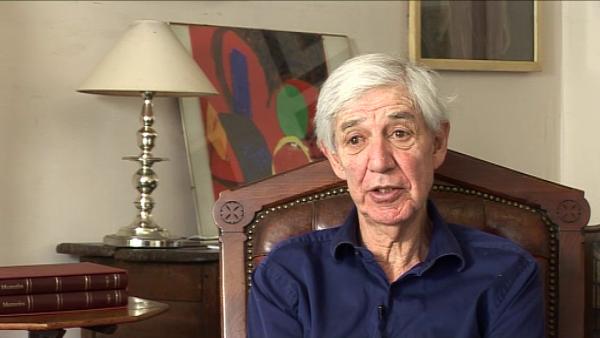NEXT STORY

Amata Hornbruch and colleagues at the Middlesex Hospital Medical School
RELATED STORIES

NEXT STORY

Amata Hornbruch and colleagues at the Middlesex Hospital Medical School
RELATED STORIES


|
Views | Duration | |
|---|---|---|---|
| 11. Sydney Brenner and Francis Crick | 529 | 03:29 | |
| 12. French Flag Model | 900 | 01:11 | |
| 13. Reaction diffusion theory that goes back to Alan Turing | 497 | 03:41 | |
| 14. Amata Hornbruch and colleagues at the Middlesex Hospital Medical... | 281 | 02:33 | |
| 15. Controversy over positional information | 277 | 02:11 | |
| 16. Left-right asymmetry | 292 | 01:44 | |
| 17. Being elected a Fellow of the Royal Society | 281 | 07:46 | |
| 18. My theory on the evolution of multicellularity | 280 | 01:10 | |
| 19. Cognitive therapy treatment for my depression | 1 | 609 | 03:44 |
| 20. Belief in cause and effect is what makes us human | 373 | 04:46 |


One way of patterning which is really quite different from positional information, is a possible way in which the digits are specified, and while the signal from the polarizing region may name the digits — this one being, you know, four, three, two, one, and so forth — the problem is how the digit... why are there these four structures. And a model that really goes back to Alan Turing, that genius who invented computers — absolute genius — and cracked the code of the enemy during the War and so forth, is based on a mechanism called reaction diffusion. And what Turing — it’s absolutely amazing — pointed out or discovered or worked out, is that if you just had two chemicals that interact with each other, one has a positive feedback, so the more you have, the more it makes of itself, but it also promotes the synthesis of an inhibitor, then blocks its synthesis. If you choose everything very nicely, then — and you start off with them all level — they form a beautiful set of peaks, and the idea is that’s how the digits may develop. And there is a little bit of evidence from that, which doesn’t come from our work but from other people’s work. If you take the early limb bud, take off the outer layer of the... the ectoderm and take the cells that give rise to the digit, disaggregate them– separate them – mix them all together, shove them back into the outer layer – graft them to the flank – they’ll form very nice digits. No polarizing region or anything like that there at all. And this looks very much like it’s a Turing model. Which are the actual molecules that give rise to it are still not identified. So although we have all sorts of models, the molecular basis of practically all of them have yet to be discovered.
And there’s another little problem that I’m involved in at the moment, and that’s the following: Compare your two hands. Compare your two digits. Isn’t it amazing that they’re pretty much the same length? I hope yours are. And if you stretch out your arms, most people’s arms are the same length. Now, your arms and legs are laid down when you’re in the embryo, and then they grow, and they grow for about 16, 17 years. How is it possible that your two arms, which grow independently — as far as we know — for 16, 17 years, end up the same length? I’ve just submitted a paper, pointing out this problem, to a journal. They didn’t like the first version and I’m waiting for my re... my revised version to be decided on, but I... I don’t have an answer to the problem, but it’s a lot... it... it’s a difficult problem because the way your arms grow is it’s due to growth plates in the skeletal elements that make each one elongate, and there are, oh, probably seven to 10 growth plates in your arm... 17 years and they’re the same length. Sorry, I just don’t know. But I have some suggestions. I think it will be very important for someone to try and simulate the growth of these regions, and maybe it’s because there are so many cells involved that the averaging out makes them reliable.
Lewis Wolpert (1929-2021) CBE FRS FRSL was a developmental biologist, author, and broadcaster. He was educated at the University of Witwatersrand (BSc), Imperial College London, and at King's College London (PhD). He was Emeritus Professor of Biology as applied to medicine in the Department of Anatomy and Developmental Biology at University College London. In addition to his scientific and research publications, he wrote about his own experience of clinical depression in Malignant Sadness: The Anatomy of Depression (1999).
Title: Reaction diffusion theory that goes back to Alan Turing
Listeners: Eleanor Lawrence
Eleanor Lawrence is a freelance science writer and editor, and co-author of Longman Dictionary of Environmental Science.
Tags: Alan Turing
Duration: 3 minutes, 41 seconds
Date story recorded: April 2010
Date story went live: 14 June 2010